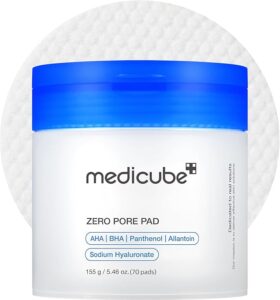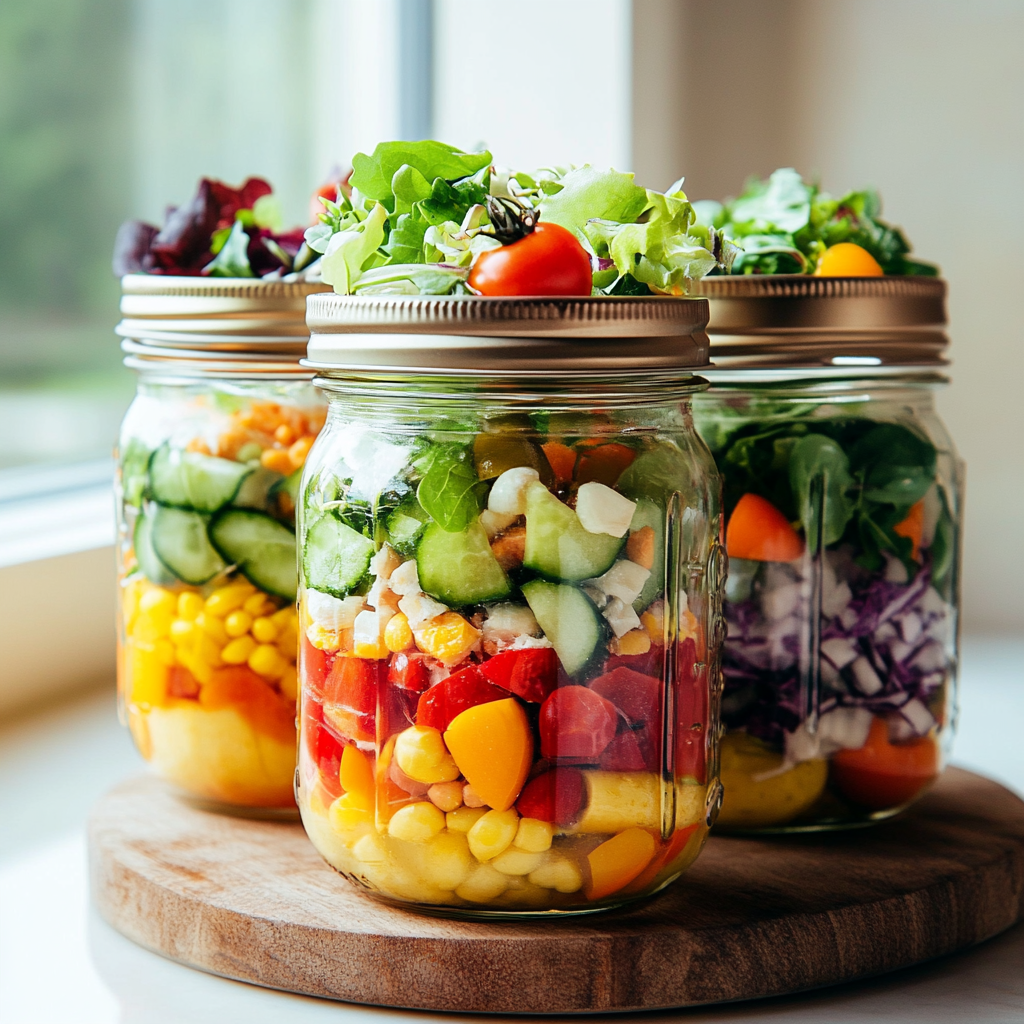Salad jars have become a go-to option for anyone seeking a quick and healthy meal. These layered salads not only look beautiful but also offer a convenient way to enjoy fresh ingredients on the go. Perfect for busy individuals, families, or even picnics, salad jars can be customized to suit any taste preference or dietary need. In this comprehensive guide, we will explore everything you need to know about creating your own salad jars at home. From ingredient selection to storage tips, you’ll find all the information necessary to make delicious and nutritious meals that can last throughout the week.
Meal prepping with salad jars saves time during hectic weekdays while ensuring you eat well. They are simple to prepare; just layer your favorite vegetables, grains, proteins, and dressings in a jar for a delightful meal that’s ready when you are. Whether you prefer classic combinations like Greek salad or unique mixtures like quinoa and roasted veggies, you’re in control of your culinary creations. So grab your mason jars and let’s dive into the world of salad jars!
Main Ingredients
Fresh Greens
Fresh greens serve as the foundation of any great salad jar. Whether you choose spinach, kale, arugula, or romaine lettuce, the greens provide essential nutrients like vitamins A and C along with fiber. Aim for about 2 cups of greens per jar. The crisp texture adds freshness and volume while making the salad satisfying without being overly heavy.
Vegetables
Incorporating colorful vegetables enhances both the visual appeal and nutritional value of your salad jars. Choose from bell peppers, cucumbers, cherry tomatoes, or shredded carrots—about 1 cup total will do nicely. Chopping these veggies into bite-sized pieces ensures they mix well with other ingredients. Each vegetable brings unique flavors and health benefits; for instance, bell peppers are rich in antioxidants while carrots boost eyesight.
Proteins
Adding protein elevates your salad from a side dish to a complete meal. Options include grilled chicken breast (around 3-4 ounces), chickpeas (1/2 cup), or hard-boiled eggs (1-2). Protein helps keep you full longer and is essential for muscle repair. Be sure to consider marinated tofu or edamame if you’re looking for plant-based alternatives.
Grains
Including grains such as quinoa or farro not only adds heartiness but also provides energy through complex carbohydrates. Use about 1/2 cup cooked grains per jar. Whole grains contribute fiber which aids digestion and helps maintain steady blood sugar levels throughout the day.
Dressings
Dressings can make or break your salad jars! Opt for homemade vinaigrettes or store-bought options that suit your taste buds but remember to keep it around 2-3 tablespoons per jar. Layering dressing at the bottom prevents sogginess while ensuring flavors meld together beautifully by mealtime.
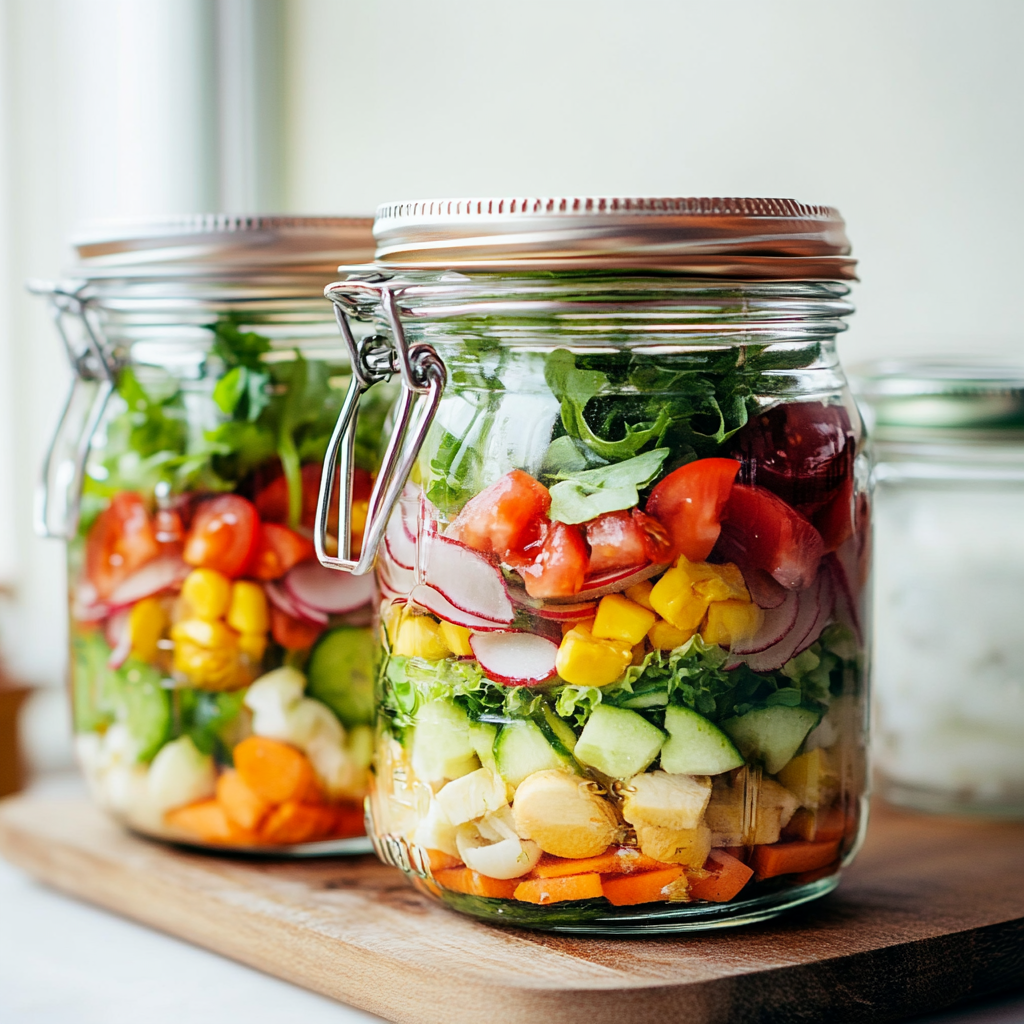
How to Prepare Salad Jars
Step 1: Gather Your Ingredients
Begin by gathering all necessary ingredients—fresh greens, vegetables, proteins, grains, and dressings—so everything is within reach as you prepare. Ensure that all components are washed thoroughly before starting this process to remove any dirt or pesticides from produce.
Step 2: Choose Your Jar Size
Select appropriate jar sizes based on portion requirements; pint-sized mason jars work well for single servings while quart-sized options accommodate larger portions or family meals. Opting for glass containers lends an aesthetic touch plus keeps food fresh longer than plastic alternatives.
Step 3: Start Layering
Begin layering with dressing first at the bottom of each jar; this prevents greens from wilting too soon by keeping them away from moisture until consumption time arrives. Follow up immediately with hearty items like grains followed by proteins next—this order ensures stability during transport.
Step 4: Add Vegetables
Next up is adding vegetables! Pack them tightly on top of proteins so they don’t shift around during movement yet remain fresh until it’s time to eat—the goal is vibrant colors peeking through clear glass! Finish off each jar by topping with fresh greens just before sealing tightly.
Step 5: Seal & Store
After assembling all layers in their respective containers securely close each lid while leaving airspace between contents if possible—this allows room for expansion should pressure build inside during storage! Store assembled salad jars in refrigerator where they’ll last up to five days without compromising flavor quality.
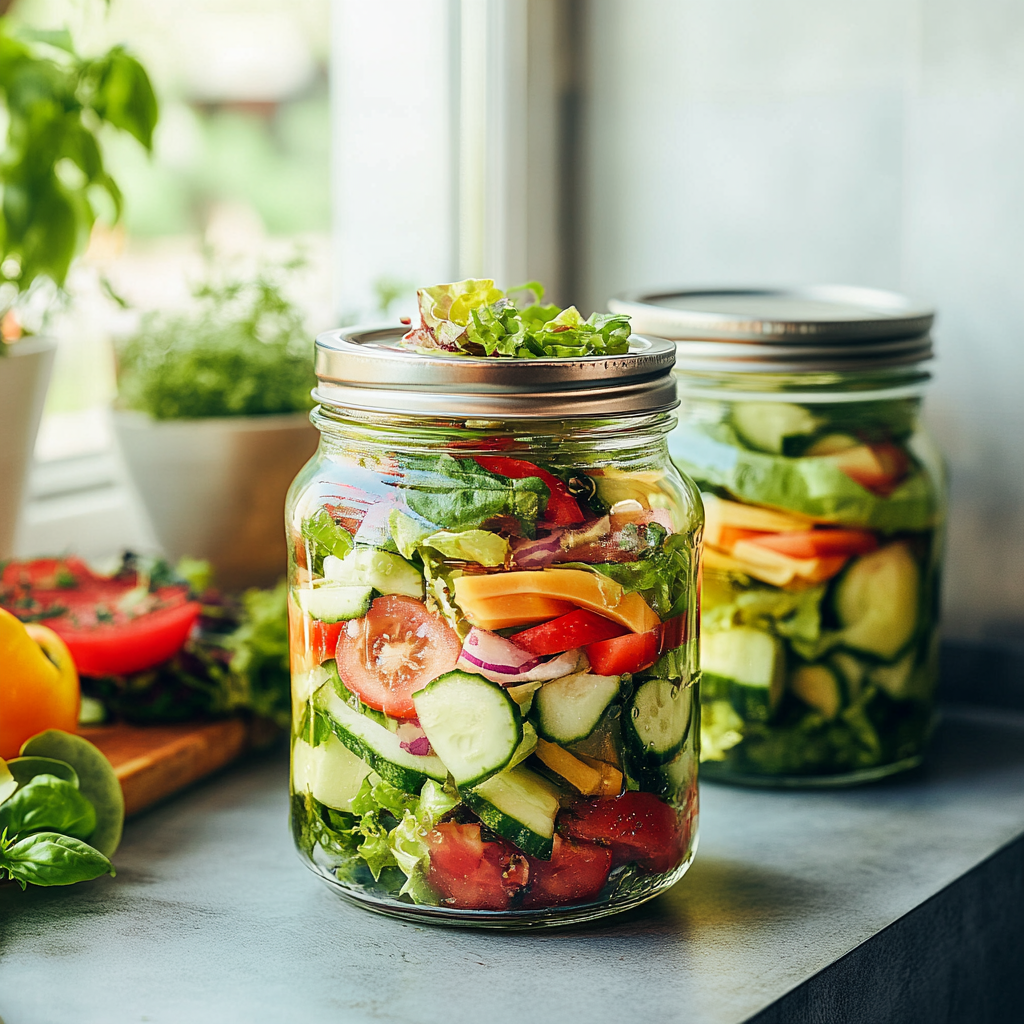
Serving and Storing Tips
Serving Suggestions
When it’s time to enjoy your delicious creation from those colorful layers served right out of its jar feels special! Simply shake gently before serving so dressing coats every ingredient evenly without losing texture integrity over time spent sitting idle in fridge once prepared.
Pairing Ideas
Consider pairing these delightful bowls with crusty bread slices dipped into olive oil or alongside some hummus served on veggie sticks—adding variety makes mealtime more exciting while ensuring balanced nutrition continues throughout day!
Storing Leftovers
If you find yourself with leftover salad after serving friends/family don’t fret; simply reassemble remaining components within another clean container following original layering instructions so freshness remains intact! Additionally labeling containers helps track which salads were made when—keeping everything organized simplifies later meal planning endeavors!
Duration & Temperature Guidelines
To ensure optimal freshness consume assembled salads within five days max stored under chilled conditions below forty degrees Fahrenheit—this minimizes bacterial growth risk allowing everyone peace of mind enjoying homemade goodness without worry about spoilage impacting health negatively!
Mistakes to Avoid
Not Layering Ingredients Properly
One of the most common mistakes when preparing salad jars is not layering the ingredients properly. The sequence in which you add items can significantly affect the texture and freshness of your salad. Always start with the dressing at the bottom. This prevents the greens from becoming soggy. Next, add hearty vegetables like cucumbers or bell peppers, followed by grains or proteins such as quinoa or chickpeas. Finally, place your leafy greens on top to keep them crisp until you’re ready to eat.
When you don’t layer correctly, moisture from the dressing can seep into your greens, making them wilted and unappetizing. Additionally, if you mix delicate ingredients with heavier ones, they might become crushed or lose their texture. Take a moment to think about how each ingredient interacts with others before adding them to your jar. Proper layering not only preserves freshness but also enhances the overall presentation of your salad jars.
Using Too Many Ingredients
Another mistake many make is using too many ingredients in their salad jars. While it may be tempting to include everything you love, this can lead to a muddled flavor and overwhelming textures. Aim for a balanced mix of flavors and colors without overcrowding your jar. Ideally, choose five to seven key ingredients that complement each other well.
Overloading your jar can also make it difficult to shake and mix the salad when it’s time to eat. A well-balanced salad jar should allow each ingredient to shine while contributing to a harmonious flavor profile. Simplifying your selections will also make meal prep easier and faster. Focus on quality over quantity for better taste and enjoyment.
Ignoring Storage Guidelines
Ignoring storage guidelines is a common mistake that can ruin your delicious salad jars before you even get to enjoy them. Always ensure that your jars are airtight and clean before filling them up; otherwise, bacteria can grow, leading to spoilage. It’s also essential to know how long different ingredients last in the fridge.
For instance, salads containing fresh herbs or delicate veggies should be consumed within three days, whereas those with sturdy ingredients may last up to a week. Labeling jars with dates can help keep track of freshness. Being aware of these storage tips will help you enjoy healthy meals throughout the week without waste.
Tips and Tricks
Choose Quality Ingredients
The first tip for making amazing salad jars is choosing quality ingredients. Fresh produce not only tastes better but also provides more nutrients. When selecting fruits and vegetables, look for vibrant colors and avoid any that show signs of wilting or bruising. Organic options may offer superior flavor and fewer chemicals, so consider shopping at local farmers’ markets or grocery stores that prioritize fresh produce.
In addition to fresh veggies, think about incorporating seasonal fruits into your salads for added flavor and nutrition. Seasonal produce tends to be fresher and more affordable than out-of-season options. Your choice of protein matters too; opt for grilled chicken, chickpeas, or beans that are high in protein but low in unhealthy fats for a well-rounded meal.
Experiment with Dressings
Another trick for creating delicious salad jars is experimenting with dressings. A good dressing can elevate even simple ingredients into something extraordinary. Instead of relying on store-bought options loaded with preservatives, try making your own dressings at home using natural oils like olive oil or avocado oil combined with vinegar or citrus juices.
Consider adding herbs and spices for extra flavor without unnecessary calories. Keep in mind that different dressings pair better with specific ingredients; creamy dressings work well with hearty grains while vinaigrettes complement leafy greens nicely. Don’t hesitate to get creative—mixing flavors can lead you to discover new favorites!
Invest in Quality Containers
Investing in high-quality containers is vital when preparing salad jars for meal prep or on-the-go lunches. Look for glass jars with secure lids that create an airtight seal; this will ensure freshness while preventing spills during transport. Glass containers are also microwave-safe if you decide to heat up any leftovers.
Choose various sizes depending on portion needs—larger jars work well for family meals while smaller ones are perfect for single servings or snacks. Also consider BPA-free plastic containers if weight is a concern during travel; just ensure they are still durable enough not to warp over time.
Suggestions for Salad Jars
Incorporate Crunchy Elements
To elevate your salad jars further, incorporate crunchy elements like nuts or seeds into your recipes. These add delightful texture while boosting nutritional value through healthy fats and protein content. Consider adding almonds, walnuts, sunflower seeds, or pumpkin seeds as toppings once you’ve layered other ingredients in the jar.
Crunchy elements provide contrast against softer items like avocado or cooked grains; this balance enhances both the eating experience and visual appeal of your dish! Just be cautious with portions since nuts are calorie-dense—keep servings controlled but satisfying.
Add Colorful Ingredients
Including colorful ingredients not only makes your salad jars visually appealing but also ensures you’re getting a range of nutrients essential for overall health! Brightly colored veggies such as red cabbage, carrots, bell peppers, and cherry tomatoes contribute antioxidants while promoting variety.
Mixing different colors helps maintain interest throughout mealtime—you’ll find yourself enjoying every bite even more! Remember that variety leads not only to better nutrition but also fun experimentation as you discover new combinations along the way!
Try Different Bases
Switching up bases in your salad jars can completely transform them! While leafy greens like spinach or kale are popular choices, don’t hesitate to experiment with alternatives like quinoa or farro as bases instead; they offer unique flavors along with added substance!
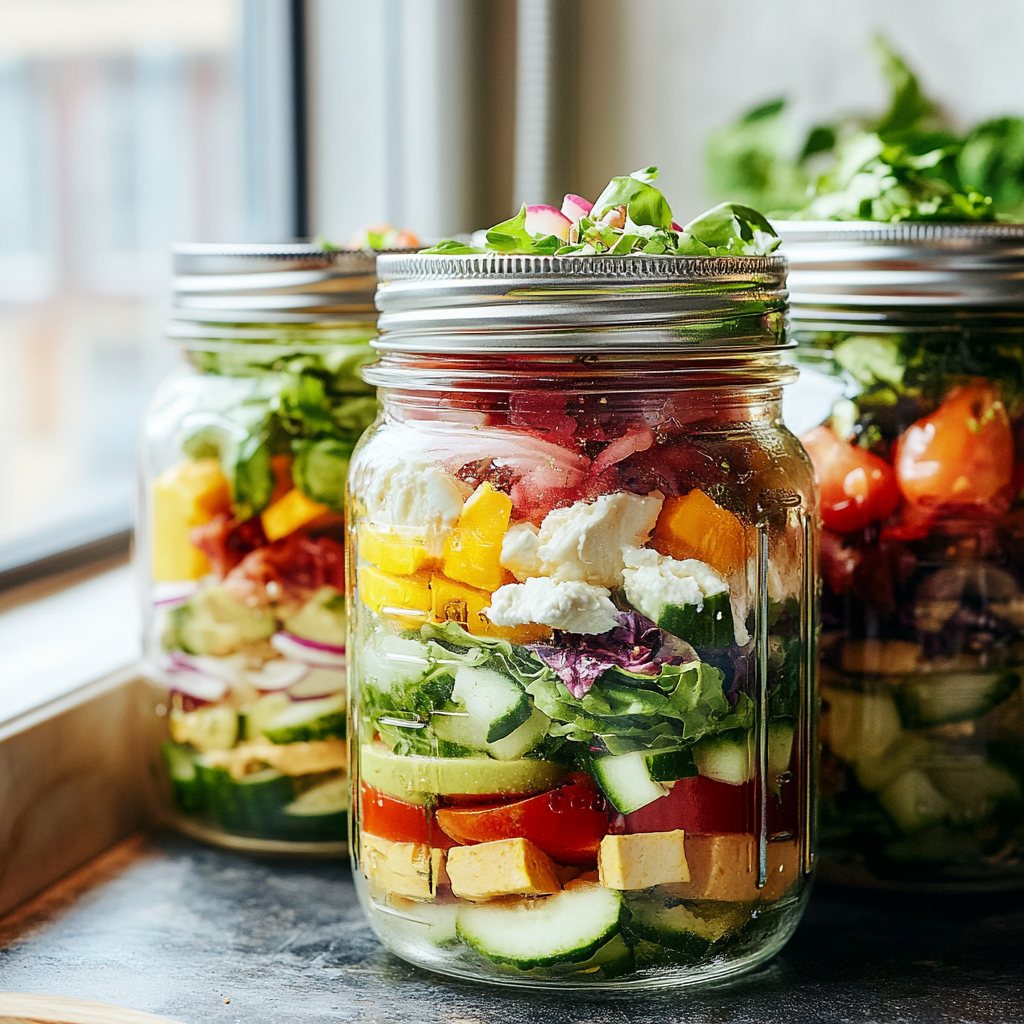
These grains provide satisfying amounts of fiber while keeping hunger at bay longer than traditional salads might do alone! Feel free also explore roasted sweet potatoes or legumes such as lentils—these additions enhance both taste profiles along with nutritional benefits!
FAQs for salad jars :
What are salad jars and how do I use them?
Salad jars are an innovative way to prepare and store salads. They consist of layering various ingredients in a jar, ensuring that each component retains its freshness until you’re ready to eat. You typically start with the dressing at the bottom to keep it away from greens, which can wilt. Next, you add hearty vegetables, grains, proteins, and finally leafy greens on top. This method not only preserves the texture and flavor but also makes meal prep easy. When you’re ready to enjoy your salad, simply shake the jar to mix the ingredients or pour them into a bowl. Salad jars are perfect for busy individuals looking for healthy options on-the-go.
How long can I store salad jars?
You can store salad jars in the refrigerator for up to five days without compromising their quality. The trick is to layer ingredients properly, starting with wet ingredients like dressing at the bottom and finishing with dry items like nuts or seeds on top. This keeps moisture away from more delicate components like lettuce or spinach. If you’re planning to prepare multiple jars for meal prep, consider using different combinations of ingredients to keep things interesting throughout the week while ensuring freshness.
What ingredients work best in salad jars?
The beauty of salad jars is their versatility; however, certain ingredients work particularly well when layered. Start with your favorite dressing as the base, followed by heavier vegetables such as bell peppers, cucumbers, or carrots. Grain options like quinoa or brown rice can provide heartiness. Add proteins like grilled chicken or chickpeas next. Finally, finish with leafy greens such as spinach or arugula at the top. Don’t forget toppings like cheese or nuts that can add crunch and flavor enhancements without making the other components soggy.
Can I make vegetarian salad jars?
Absolutely! Salad jars are an excellent choice for vegetarians and can be completely plant-based if desired. You can use a variety of colorful vegetables along with grains and legumes for protein. Ingredients such as chickpeas, black beans, or lentils offer great nutritional value and texture. Additionally, include nuts and seeds for crunch and healthy fats. Experimenting with different dressings can also elevate your vegetarian salad jar game and keep your meals exciting.
Are salad jars suitable for meal prep?
Yes! Salad jars are perfect for meal prep due to their convenient storage format and ability to maintain freshness over several days. Preparing multiple jars at once saves time during busy weekdays when you need quick meal options. You can customize each jar according to your dietary preferences or caloric needs while ensuring that you have healthy lunches or snacks ready to go. Just remember to layer correctly to maximize freshness from day one until you eat them.
How do I choose the right size jar for my salads?
Choosing the right size jar depends on how much salad you plan to eat in one sitting. A standard pint-sized mason jar typically holds about two cups of ingredients, which is great for a filling lunch option. For larger meals or if you wish to include extra toppings like breadsticks or fruit on the side, consider using quart-sized jars that offer more space without overcrowding your ingredients. Always aim for a jar that allows enough room for shaking without spilling while still being compact enough for easy transportation.
Print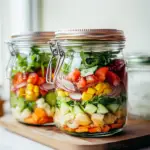
Salad Jars
- Total Time: 15 minutes
- Yield: 4 servings
Description
Salad jars are the ultimate meal prep solution for busy individuals seeking healthy, delicious options on the go. These layered salads not only look vibrant but also keep your ingredients fresh and flavorful until you’re ready to enjoy them. Customize your salad jars with a variety of fresh greens, colorful vegetables, hearty grains, and protein-packed additions to suit your taste preferences and dietary needs. Perfect for lunch at work or a quick snack at home, salad jars make eating well effortless and enjoyable.
Ingredients
– Fresh greens (spinach, kale, or romaine)
– Colorful vegetables (bell peppers, cucumbers, cherry tomatoes)
– Protein (grilled chicken, chickpeas, or hard-boiled eggs)
– Grains (quinoa or farro)
– Dressing (homemade vinaigrette or store-bought)
Instructions
1. Gather all ingredients and wash them thoroughly.
2. Choose pint-sized mason jars for single servings.
3. Layer ingredients starting with 2-3 tablespoons of dressing at the bottom.
4. Follow with grains, proteins, vegetables, and finish with fresh greens on top.
5. Seal tightly and store in the refrigerator for up to five days.
Notes
– Experiment with different dressings to enhance flavor.
– Add nuts or seeds for extra crunch.
– Use seasonal produce for freshness and variety.
- Prep Time: 15 minutes
- Cook Time: 0 minutes
Nutrition
- Calories: 350
- Fat: 15g
- Carbohydrates: 40g
- Protein: 20g
Salad jars represent an innovative solution for anyone seeking healthy eating options while managing a busy lifestyle. By layering fresh ingredients in a compact container, they not only look appealing but also ensure maximum freshness when it’s time to consume them. The key points involve understanding how long you can store them—up to five days—while utilizing proper layering techniques that keep delicate greens crisp and flavorful.
Remember to experiment with various ingredient combinations based on personal preferences; this ensures every meal feels unique yet satisfying throughout your week’s lunches or snacks. Whether you’re making vegetarian versions packed with legumes or hearty mixed salads loaded with proteins and grains, there’s no limit to creativity when assembling these delightful portable meals.
Incorporating salad jars into your weekly routine simplifies meal prep while promoting healthier eating habits effortlessly; so why wait? Start preparing your own delicious salad jars today!
